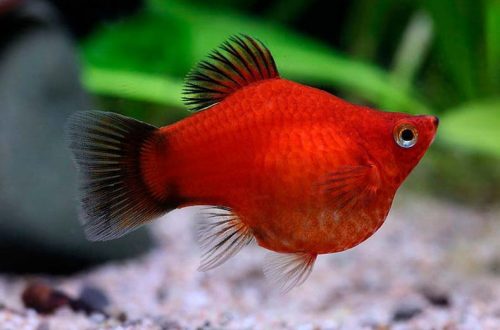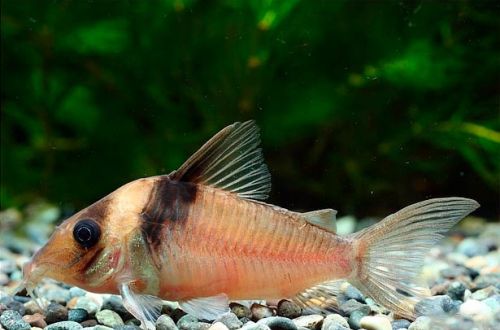
Rasbora Measures
Rasbora Merah, scientific name Boraras merah, belongs to the Cyprinidae family. The name indicates the main color of this fish. Merah means “red” in Indonesian. It is one of the smallest aquarium fish, easy to keep and compatible with other species of comparable size. May be recommended for beginner aquarists.

Contents
Habitat
Endemic to the southern part of the island of Borneo in Southeast Asia. Inhabits swamps and associated rivers and streams flowing under the canopy of the tropical forest. The water in the natural habitat is colored brown due to the high concentration of tannins released during the decomposition of plant organic matter – the bottom of natural reservoirs is strewn with fallen leaves, twigs and other things.
Currently, the habitat of Rasbora Merah is under threat of extinction due to active human activities: palm and rubber plantations, oil production, etc.
Brief information:
- The volume of the aquarium – from 40 liters.
- Temperature – 20-28°C
- Value pH — 4.0–6.5
- Water hardness – soft (1-5 dGH)
- Substrate type – any
- Lighting – subdued
- Brackish water – no
- Water movement is weak
- The size of the fish is 1,5–2 cm.
- Food – any food
- Temperament – peaceful
- Keeping in a group of 8-10 individuals
Description
Adults reach a length of only about 2 cm. The color is red with a gray back. The main feature in the body pattern is a large black spot on a reddish background. Sexual dimorphism is weakly expressed and consists mainly in the size of the fish. Females are somewhat larger with a rounded abdomen, while males have more intense coloration. True, the last sign is not so obvious.
Food
In nature, it feeds on small zooplankton. The home aquarium will accept most popular foods (dry, fresh, frozen) in a suitable size. The daily diet may look like this: dry flakes, granules in combination with daphnia, artmemia. Food saturated with protein contributes to the manifestation of a better color and has a positive effect on the tone of the fish, which is especially important during reproduction.
Maintenance and care, arrangement of the aquarium
The optimal dimensions of the aquarium for a small flock of Rasbor Measures start from 20-30 liters. The design of the aquarium should resemble the natural habitat, so it is recommended to use sandy soil, a lot of shade-loving plants, including floating ones, and various snags. The lighting is subdued.
To give the water a characteristic brown color, you can use fallen leaves of European trees, or more exotic leaves and bark of Indian almonds. Read more in the article “Which tree leaves can be used in an aquarium.”
The maintenance of this species is quite simple and will require several standard care procedures from the aquarist: weekly replacement of part of the water with fresh water, regular removal of organic waste (excrement, food debris) and plaque, maintaining stable hydrochemical values.
When choosing a filtration system, give preference to those models that do not create excessive water movement. These fish come from stagnant waters, so they are not adapted to strong/moderate currents.
Behavior and Compatibility
A peaceful schooling fish, it can complement the community of other similar miniature species. It is worth avoiding combining with large neighbors, which pose a potential danger to such small fish.
Keeping at least 8–10 individuals in a group, with a smaller number, Rasboras will become shy and will probably hide in shelters for a significant part of the time.
Breeding / breeding
In favorable conditions and in the presence of sexually mature males and females, spawning occurs quite often. The fish scatter many eggs that sink to the bottom and from that moment on they become left to their own devices. There is no parental care. Moreover, the newly-minted “parents” can eat their own caviar. Therefore, in the general aquarium, fry rarely grow to adulthood.
If you plan to save the entire brood (or part of it), then it is worthwhile to prepare a separate tank (10-15 liters) in advance with identical water conditions. This kind of spawning aquarium is equipped with a simple airlift filter with a sponge, a heater and a lighting system. A few shade-loving plants or ferns are quite sufficient as decoration.
At the end of spawning, the eggs are carefully placed in a hotel aquarium. The incubation period lasts about two days. A day later, the fry begin to swim freely in search of food. The main problem at this stage is feeding. For tiny juveniles, appropriate food is needed, shoe ciliates or specialized powdered food are ideal. As they grow older, the diet can be diluted with brine shrimp nauplii.
Fish diseases
Hardy and unpretentious fish. If kept in suitable conditions, then health problems do not arise. Diseases occur in case of injury, contact with already sick fish or significant deterioration of the habitat (dirty aquarium, poor food, etc.). Read more about symptoms and treatments in the Aquarium Fish Diseases section.





